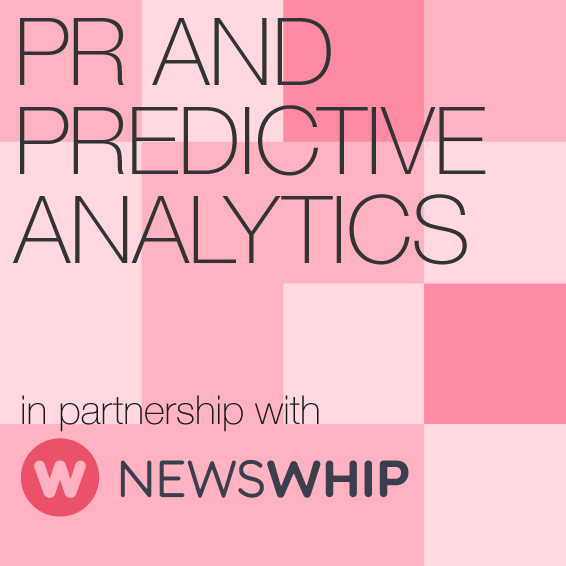Aarti Shah 28 Jun 2019 // 6:58PM GMT

This is the second of a three-part series on the topic of PR and predictive analytics. Part 1 can be found here.
When Marshall Manson, a partner at the Brunswick Group, learned that an NGO was preparing a report that was critical of one of his clients, his response strategy hinged on predictive analytics. The team compiled a dozen previous reports from the same NGO to measure the relative media and social media interest around their releases. They took this historical context to build their own parameters to predict the impending report's impact for their client.
“When the report appeared, we knew within minutes that the impact was on the lowest end of our benchmarks, and the client was able to calibrate their response accordingly,” Manson said. Within an hour of the report’s publication, the client opted to limit its response to direct questions from customers, while also managing the story with a small number of journalists who showed interest.
“Benchmarking is now a critical part of any crisis preparedness exercise,” Manson added.
Perhaps the lofty aspiration for predictive analytics was a crystal ball that would foretell public behavior with massive amounts of data from multiple sources — web analytics, social media, CRM, artificial intelligence, and beyond. But, at this point, it seems clear that crunching colossal stockpiles of data is far too complex and expensive for most day-to-day decision-making. The reality of predictive analytics, instead, can be distilled into a relatively simple practice: apply data from past events to anticipate future responses.
“Predictive analytics uses data from events that have already occurred to look ahead and provide insight about what’s likely to happen next,” Manson said. “Lots of people ramble on about the potential of data. But data is only valuable when it can inform and drive decision-making.”
One might wonder, then, if predictive analytics is simply historical benchmarking remade for the modern era. Chris Gee, managing director at Finsbury, cautions against conflating the two, maintaining that historical benchmarking can provide insight to make an educated guess but predictive analytics should provide some scientific probability.
“It’s the difference between saying ‘it rained every day this week, I think it will rain again today’ versus ‘there is a 75% chance we will have thundershowers between 4-6pm today,’” he said.
The Social Media Variable
Of course, a huge variable in predicting any crisis is social media. The impact that platforms have on the way a crisis unfolds is pretty well documented: news and information (including disinformation) travels faster than ever and online opinions tend towards inflammatory and volatility.
Even so, not every situation is equal. The potentially lethal Tide pod challenge warranted a cautious response that didn’t encourage copycats while also making it clear the pods should not be eaten. In this case, social media platforms took down videos on the dangerous behavior. P&G used the full range of platforms to get out warnings. But for every Tide Pod challenge, there are numerous minor shockwaves— like Chick-fil-A forgetting that Alaska is part of North America, and even more that fall in-between those two.
In our crisis review from earlier this year, Careen Winters, MWWPR’s chief strategy and reputation officer, pointed out how Tide “finds itself in the crosshairs of a new breed of crisis — misuse of its product to create individual social celebrity. This situation is becoming increasingly common, even coining the new term ‘selficide’ where people die in pursuit of extreme selfies, and is not something any crisis playbook of the past would anticipate.”
With predictive analytics, however, are there certain thresholds that signal a more serious situation that warrants early intervention? Brunswick’s Manson says decision-makers should pay close attention to the reaction patterns around an issue.
“Every crisis will have an initial spike. It might follow a slow build-up or a swift one, depending on how the news breaks or is discovered,” he said. “Most crisis will have a second spike, often because people are reacting to the original news. The bad ones have a third spike, where people are reacting to the reactions, or where the news has spread to a new — and usually larger — audience, which is sharing and reacting. The worst situations wind up looking like an unhealthy EKG, where the story dies down, and then blows up again. For decision-makers, there are potential opportunities for intervention in each spike, but the presence of a third spike almost certainly demands a response.”
Meanwhile, Finsbury’s Gee says quantifying a proportional response can be tricky, given the numerous variables at play. He recommends gauging responses by “conversation velocity” or determining “the rate at which a conversation will escalate over the next 12 hours. A rapidly escalating conversation around a specific event that continues to build momentum is more concerning than a conversation that spikes for 1-2 hours then loses steam.” Then, compare this velocity against historic context for the brand to arrive at a relatively accurate understanding of the situation.
Purpose Fatigue
“Purpose-washing” and “woke-washing” emerged at Cannes this year as the inevitable backlash to companies taking tepid stands on issues, without often backing these positions with adequate actions. The heightened consumer scrutiny, coupled with purpose fatigue, means brands might lean more heavily on data to decipher whether stepping into an issue makes sense. Paul Quigley, CEO of NewsWhip, recalled the platform’s work with the agency of a tech company looking to take a leadership position on labor rights at its West Coast facilities.
“The CEO of the company felt the brand had a right to speak on the issue and would benefit from it,” Quigley said. “The agency team looked at 12 months of content engagement and social posts around related topics. They examined exactly which angles and topics within labor rights spark discussion and engagement on the West Coast, and the quality of that engagement.”
Yet when examining the intersection between the topic and the company, the team noticed unfavorable narratives gaining strong engagement. The data indicated the company’s involvement with the issue was perceived as contrived or hollow.
“The company had other areas of strong corporate purpose where it was perceived as having real authentic voice, so instead it stuck to those,” Quigley said.
The Human Factor
The conversation around predictive analytics has consistently reinforced the need for humans to ultimately drive data-driven decisions because without context, the numbers can be misleading or misinterpreted. Dan Mazei, who most recently led Reebok’s global newsroom, cautions that “there are so many tools in the marketplace, so many vendors we're using, that we can justify virtually any decision — good, bad and otherwise — under the comfy shield of data.”
When considering a quick response to an emerging crisis, Maizei sifts through data to understand what people are saying about the subject, how long the subject will be relevant and how people’s interest or perspective might change over time.
“I think marketers are just scratching the surface of what's possible with predictive analytics,” Maizei said. “But the willingness of brands recently to be bolder in execution — be it tackling provocative issues or being an active observer of culture — is giving us a lot more real-time case studies.”



































.jpg)


















